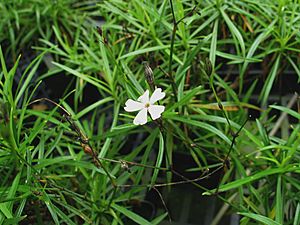Cliff-face catchfly facts for kids
Quick facts for kids Cliff-face catchfly |
|
|---|---|
 |
|
| Conservation status | |
| Scientific classification | |
| Genus: |
Silene
|
| Species: |
perlmanii
|
Silene perlmanii, also known as the cliff-face catchfly, is a very rare flowering plant. It belongs to the Caryophyllaceae family, which includes many types of flowers like carnations. This special plant is found only in Hawaii, specifically in the southern Waianae Mountains on the island of Oahu. Sadly, you won't find any of these plants growing in the wild anymore. The good news is that some are being grown carefully at the National Tropical Botanical Garden to help save the species. The United States government lists it as an endangered species, meaning it needs special protection to survive.
Contents
What is Silene perlmanii?
Silene perlmanii is a small, woody plant, sometimes called a subshrub. This means it's like a small bush. It has beautiful white flowers. Scientists first discovered this plant in 1987. It was given the common name "cliff-face catchfly" because it used to grow on steep cliffs.
A Rare Hawaiian Plant
This plant is endemic to Hawaii. This means it naturally grows nowhere else in the world. When it was first put on the endangered species list in 1991, there were only about 10 to 20 plants left. They were all found clinging to cliff faces in the wet forests of the Waianae Mountains.
Why is it Endangered?
By 1997, all the wild Silene perlmanii plants had disappeared. This is a big problem because it means the plant is now extinct in the wild. This can happen for many reasons, like habitat loss, new plants or animals arriving that harm them, or changes in the environment.
Helping the Plant Survive
Even though it's gone from the wild, Silene perlmanii still exists thanks to people growing it in special gardens. This is called cultivation. Scientists and gardeners at the National Tropical Botanical Garden are working hard to keep the species alive.
They have even tried planting some of these cultivated plants back into their natural home. This is called "outplanting." As of 2008, three of these outplanted individuals were still alive. They are protected inside fenced areas to keep them safe from harm. This work is very important for trying to bring the cliff-face catchfly back to the wild.


